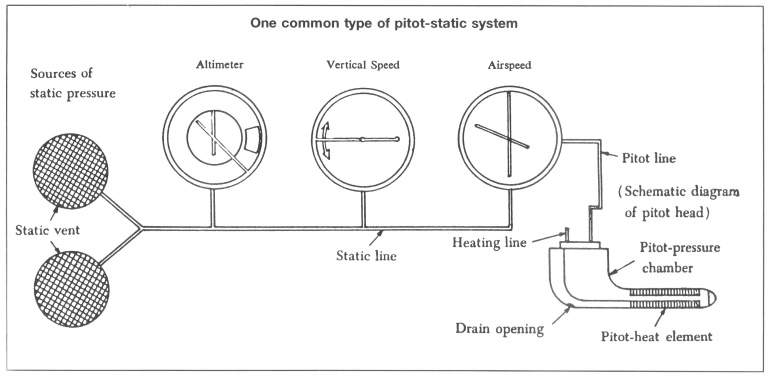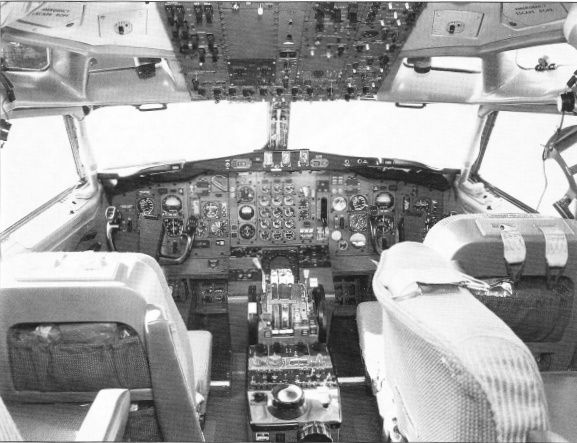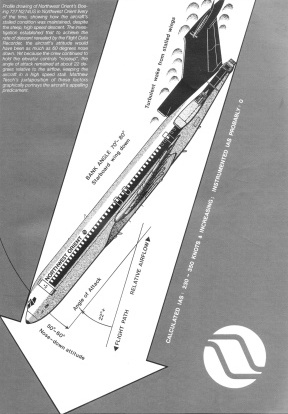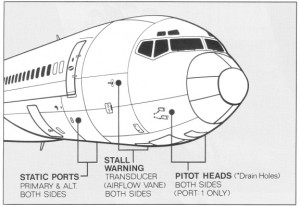“By lucky chance this was a ferry flight…”
[Reproduced from Air Disaster Volume 1 with the kind permission of author Macarthur Job and artist Matthew Tesch]
Undue haste in completing the pretakeoff checklist, and a first officer inexperienced on the aircraft type, set the stage for erroneous and misleading airspeed indications. But greater attention to the attitude instruments could have shown the errors for what they were – and averted a tragedy.
On the face of it, it seemed only appropriate that the Northwest Airlines crew rostered for a night charter flight were all enthusiastic young men in their early thirties.
It was December 1, 1974, and the aircraft had been hired by a professional football team to pick up its players and their support team from Buffalo, New York State.
Officially designated Flight NW6231, the aircraft allocated to the task was Northwest Orients five year old N274US, a Boeing 727-251, under the command of Capt John Lagorio, 35.
With eight years service with the airline, Captain Lagorio was well experienced on the aircraft type, had a total of about 7500 hours, and had held a command rating for five years. Lagorio’s first officer for the flight, Walter Zadra, 32, though only recently upgraded to this position, had been with the company for nearly the same time. A former flight engineer on Boeing 707s, he had become a 727 first officer six weeks previously, and had since flown nearly 50 hours in his new role. Even so, 1500 hours of his total 3700 hours flying time had been logged as a pilot.
Flight Engineer James Cox, 33, had nearly 2000 hours with the airline in this capacity, 1000 of it in Boeing 727s.
To undertake the charter flight, the Boeing 727, based at John F Kennedy Airport, New York, had first to be ferried to Buffalo, on Lake Erie near the western extremity of New York State, a 40 minute trip over a distance of about 265 nautical miles.
The weather forecast that cold winter evening predicted overcast cloud at 5000 feet, with a wind from the northwest at between 14 and 24 knots. Moderate to heavy rain and scattered thunderstorms, with tops to 28,000 feet, were expected over the eastern portion of the route, while moderate to heavy snow-showers were likely on the western section of the Appalachian Mountains. Freezing level was at the surface, with icing likely in cloud.
With only the flight crew on board, the Boeing 727 took off at 7.14pm on a standard instrument departure clearance and, on taking up its westerly heading, was cleared to climb to 14,000 feet. At 7.21pm the New York ATC Centre assumed radar control of the flight, clearing it now to climb to its planned en route Flight Level 310 (31,000 feet).
Only three and a half minutes later, when the Boeing 727s position on the New York ATC Centre’s radar was three nm beyond Bear Mountain, 35nm northwest of John F Kennedy Airport, the air traffic controller handling the aircraft was startled to hear it transmit an emergency call.
Aircraft: “Mayday, mayday”
Controller: “Flight 6231 … go ahead!”
Aircraft: “Roger… we’re out of control… descending through 20,000 feet.”
In response to the controllers urgent questions, the flightcrew member operating the radio replied desperately: “We’re descending through 12 (thousand feet) – we’re in a stall!”
Apart from a brief unmodulated radio transmission 17 seconds afterwards, there were no further calls from the aircraft.
The unburnt wreckage of the Boeing 727 was found in a forest on the side of Bear Mountain later that evening, just over five kilometres west of the town of Thiells and about 35km north of the city of New York. All three flightcrew members, the only occupants of the aircraft, had been killed.
National Transportation Safety Board investigators who reached the crash site later that night found that the Boeing 727 had struck the tree covered 10 degree mountain slope in a slightly nose down and starboard wingdown attitude at an elevation of 1090 feet.
Detailed examination of the distorted and disintegrated aircraft structure on the frozen ground of the forest early the following morning established that, except for the port side tailplane and the tips of both elevators, all the Boeing’s wreckage lay within an area only 55 metres long and 30 metres wide. The missing components were later found scattered between 115 and 1280 metres away from the main wreckage, showing conclusively that they had separated from the aircraft before its impact with the ground.
The Nos 1 and 3 engines had broken away from their tail mounting pylons, but the No 2 engine remained in its mounting in the tail assembly. All the engine damage was clearly the result of impact forces and it was evident that all three were at high power settings when this occurred. The undercarriage and spoilers were retracted at the time, and the flaps lowered two degrees, with Nos 2, 3, 6 and 7 leading edge slats fully extended, positions consistent with the flap setting.
There was nothing to suggest that any of the aircrafts systems had malfunctioned prior to impact with the ground, but two of the aircraft’s five pitot heads – the captain’s and the port elevator pitot head – were found to contain water or ice. Those for the copilot and the auxiliary system were too severely damaged to be checked for water, while the starboard elevator pitot head, still attached to the fin, was in good condition.
Amongst the remains of the flightdeck, the aircraft’s three damaged attitude indicators were all showing 20 degrees nosedown, with the wings almost level. The two pitot head heater switches on the overhead panel above the copilot’s seat were in the off position, with the toggles bent backwards, indicating they had been in this position at the moment of impact.
The aircraft’s Flight Data and Cockpit Voice Recorders were both damaged, but their tapes were intact. A readout of the FDR traces was found to cover 11 minutes 55 seconds of flight, beginning from shortly before liftoff. The CVR tape began with the crew’s conduct of the pretakeoff checklist shortly after 7.00pm, and terminated with the sounds of impact three seconds before 7.26pm.
Air-to-ground communications recorded by the three ATC units that handled the Boeing – Control Tower, Departures Control and the New York ATC Centre – were correlated with the CVR transcript and FDR readout to give a comprehensive account of what had happened aboard the aircraft in its brief 12 minutes of flight.
The progress of the flight appeared perfectly normal until the aircraft, cleared to Flight Level 310, was climbing through 16,000 feet at an airspeed of 305 knots and at a climb rate of 2500 feet per minute. At this stage, with no change in engine power setting, the airspeed indication began to increase, and with it the rate of climb.
Surprised by this apparent performance, First Officer Zadra, who was flying the aircraft, remarked to the other crew members: “Do you realise we’re going 340 knots and climbing 5000 feet per minute?”
The crew talked briefly about the reason for this spirited performance (actually beyond the capability of the aircraft), Flight Engineer Cox concluding: “That’s because we’re light.”
But far from falling off as they gained more altitude, the airspeed and rate of climb continued to increase, despite Zadra exerting back pressure on the control column to prevent the airspeed becoming excessive. By the time the aircraft was climbing through 23,000 feet, the rate of climb was more than 6,500fpm and the airspeed indication had risen to 405 knots, triggering the overspeed warning horn. “Would you believe that!” exclaimed Captain Lagorio.
“I believe it,” Zadra retorted. “I just can’t do anything about it!”
No crewmember suggested that the pitot system could possibly be at fault, causing erroneous readings.
Lagorio: “Pull her back and let her climb.”
Again the overspeed warning horn sounded, followed 10 seconds later by the stick-shaker stall warning, accompanied by slight negative g and the altimeter reading levelled at 24,800 feet with the airspeed indicators reading 420 knots.
But the crew, apparently convinced the airspeed was in fact excessive, failed to recognise the continuing stall warning.
Zadra: “There’s that Mach buffet – I guess we’ll have to pull it up (further).”
Lagorio: “Pull it up!”
At this point the undercarriage warning horn sounded, indicating that one of the pilots had pulled the throttles closed. Two seconds later, there was a brief period of negative g as the aircraft fell into a spiral dive to the right, the rate of descent rapidly increasing to 15,000fpm as the vertical acceleration increased again to 1.5, prompting Lagorio to transmit the aircraft’s Mayday call.
Just over half a minute later Lagorio reported they were descending through 12,000 feet in a stall and five seconds after this he called to Zadra, “Flaps Two!”
The sound of the flap lever being moved followed, after which there was an immediate further increase in vertical acceleration, with peaks to 3g. But there was no change in the rate of descent, the airspeed indication reduced to zero, and the noise of the stall warning became intermittent.
Five seconds later, Zadra said urgently (obviously to Lagorio): “Pull now! Pull…that’s it!”
The vertical acceleration then increased further to a severe 5g. But the rate of descent lessened only slightly and the dive continued unchecked.
Eighty three seconds after the Boeing fell into the spiral dive at an altitude of 24,800 feet, there was the noise of initial impact as the aircraft struck the mountain treetops at a terrain elevation of 1090 feet. At this point the recording ended abruptly.
At the time of takeoff the Boeing 727-251 was laden with 22,000kg of fuel and its gross weight was 66,740kg. This weight, as well as the centre of gravity, were within prescribed limits. The aircraft was fully airworthy in all respects.
In the Boeing 727, the pitot-static instruments on the captain’s panel, those for the copilot, and the pitot-static instrumentation for the FDR, are connected to separate pitot and static sources in the nose of the aircraft. Each pitot head and static port incorporates a heating element to prevent icing, with the pitot heads also having a small drain hole for exhausting moisture. The three pitot systems are completely independent, as are the three static systems, except for manual selector valves enabling either the captain or the copilot to select the FDR static system as an alternative source if either primary source malfunctions. The copilot’s pitot-static system is also connected to the switch activating the overspeed warning horn, and a second warning system switch is incorporated in the FDR pitot-static system.
In addition to these flightdeck pitot-static systems, two further independent systems are connected to the elevator feel mechanism in the aircraft’s longitudinal controls, the control column force required to move the elevators varying as a function of the dynamic pressure measured by these two pitot-static systems. The two pitot heads are similar in design to the pitot heads mounted on the nose, and are mounted on either side of the fin. As with the nose mounted pitot-static sources, each of the tail mounted pitot heads and static ports incorporates a heating element to prevent icing.
Northwest Orient Airlines’ operational procedures require the flight engineer to read the pretakeoff checklist, to which the captain and first officer respond as the checklist tasks are accomplished. The portion of the checklist which includes switching on the heaters for the pitot-static system reads as follows:
Flaps (15 or 25 degrees as required)
Marked bug (moveable marker on airspeed indicator dial to show rotation speed)
Ice protection (engine nacelle heat)
Pitot heat
The CVR transcript showed that after First Officer Zadra responded to Flight Engineer Cox’s flap setting call, and Cox called for the “bug” setting, there was no immediate response by either Captain Lagorio or Zadra. As a result, the engine ice protection call was missed:
Zadra: “…15, 15…blue”
Cox: (without waiting for response) “Pitot heat?”
Zadra (apparently responding both to the missed engine anti-ice item and the pitot heat call): “Off and on.”
Lagorio: “One forty-two is the bug setting.”
Zadra: “Er… do you want the engine heat on?”
Zadra: “Huh?” (probably responding to Lagorio’s nod or hand signal).
Sound of five clicks.
A Boeing Company analysis of the data recorded on the FDR and CVR showed that the airspeed and altitude figures were consistent with the aircraft’s climb capability until it reached 16,000 feet. But from this point on the simultaneous increases in airspeed and rate of climb began to exceed the theoretical capability of a 727-200, varying directly with the increase in altitude, as would be expected if the pressure in the pitot system remained constant after climbing through 16,000 feet – in other words if the pitot heads had become blocked.
The actual airspeed when the stick shaker stall warning first activated was calculated to be 165 knots, compared to the 412 knots recorded by the FDR, with the aircraft’s attitude about 30 degrees noseup.
The normal 1g vertical acceleration acting on the aircraft and its occupants reduced slightly to 0.8g as it levelled out at 24,800 feet, probably because the pilot relaxed the back pressure he was holding on the control wheel, and the stick shaker ceased momentarily. But because of the drag induced by its high nose attitude, the aircraft continued to decelerate, and the stick shaker stall warning was activated again. The second small increment of negative g after the throttles were retarded, coincided with a sudden descent and a rapid change of heading to the right – the result of an aerodynamic stall with a simultaneous loss of lateral control as the aircraft fell into a spiral dive.
The analysis showed that even after the stall, the aircraft reached an angle of attack of 22 degrees or more as it descended. To achieve this angle of attack as well as the measured descent rate of nearly 18,000fpm, the aircraft’s attitude would have been more than 60 degrees nosedown at times. The variations in g loadings, averaging about 1.5g at this stage, were probably the result of variations in the aircraft’s angle of bank.
As the aircraft descended through 11,000 feet, exceeding 230 knots in a nosedown attitude of at least 50 degrees, the crew extended the flaps to two degrees. The momentary pause in the operation of the stick shaker at this point indicated this had reduced the angle of attack to less than 13 degrees, while the simultaneous increase in vertical acceleration or load factor to more than 2.5g showed the aircraft was in a tight nosedown spiral with a bank angle of between 70 and 80 degrees.
To achieve a load factor of 2.5g at an airspeed of 250 knots and an altitude of 5000 feet, provided the elevator feel system was operating normally and the aircraft trimmed to climb, a pilot would have to exert a force of between 20 and 23kg on the control column. However, if the elevator pitot system was blocked, thereby upsetting the elevator feel system, a pull force of less than 14kg would produce the same result.
After it descended through 5000 feet, the load factor being imposed on the aircraft rose to 5g, causing part of the tail assembly to fail structurally.
Boeing engineers calculated that the aircraft’s structural limits would have been exceeded at high angles of sideslip and a load factor approaching 5g.
The erroneously high airspeed indications during the aircraft’s climb were clearly caused by a complete and nearly simultaneous blockage of all three pitot pressure systems in the nose of the aircraft. The investigators were convinced that the blockages were created by ice forming around the heads, closing the pressure inlet ports and the drain holes.
This conclusion was supported by the moisture found in the pitot heads after the accident, and by the known icing conditions that existed at the time of the flight. The captain of another Northwest Orient aircraft flying the same route behind the Boeing 727 told investigators that he encountered icing conditions and light turbulence during his climb. His aircraft was in solid instrument conditions from 1500 feet to 23,000 feet, except for a short interval between cloud layers.
This ice formation should have been prevented by electrical heating elements in the pitot heads controlled by switches located on the pilots’ overhead panel on the flightdeck, but these switches had obviously not been turned on.
Why this was so was not entirely clear. However, in performing the pretakeoff checks required by Northwest Orient’s operational procedures, the crew did not follow the checklist sequence with precision. Because of momentary confusion resulting from an omission in the sequence, it is possible that the switches were positioned incorrectly by a first officer inexperienced as a Boeing 727 copilot.
While reading the checklist, the flight engineer called “Bug?” in the normal way. But before receiving a response from either the captain or the first officer, he omitted the [engine] ice protection call and went on to call, “Pitot heat?”
Apparently responding both to this and the omitted call, the first officer answered, “Off and on”. But then, following the captains late response to the “bug” call, he asked whether engine heat was needed.
To this the captain evidently responded with a nod or a hand movement, because the sound of five switch clicks followed before the first officer returned to setting his airspeed bug. The investigators believed these five clicks might have been the switching of the pitot heaters to their off position, and the engine anti-ice to the on position – an inadvertent reversal of the normal switch positions. Their assumption was supported by the position of the switches in the wreckage, light bulb filament evidence that the engine anti-ice lights were illuminated at impact, and the lack of any reference during the flight to the need for engine ice protection.
No doubt strongly influenced by the fact that both airspeed indicators were showing the same readings, the crew initially attributed the high airspeed and rate of climb to the lightly laden aircraft’s low gross weight, in conjunction with encountering a powerful updraught in the prevailing solid instrument conditions, with the presence of thunderstorms forecast.
Even so, the aircraft’s attitude as it neared the top of its climb should have told them that the apparent performance was impossible. Its 30 degree noseup attitude was no less than 25 degrees higher than the normal climb attitude, and in this condition the airspeed could never have increased, even if influenced by extreme updraughts.
Because the use of attitude reference is fundamental to instrument flying, and indeed is stressed in Northwest Orient’s own crew training programmes, the investigators concluded that in this case the crew relied on airspeed indications to the detriment of what the aircraft’s attitude indicators would have been telling them, so missing the vital cues that could have enabled them to recover normal flight.
 While the sounding of the overspeed warning horn probably reinforced the crew’s belief that they were acting correctly, the operation of the stick shaker stall warning should have alerted them to the true situation. Yet the first officer misinterpreted this as Mach buffet and the captain agreed.
While the sounding of the overspeed warning horn probably reinforced the crew’s belief that they were acting correctly, the operation of the stick shaker stall warning should have alerted them to the true situation. Yet the first officer misinterpreted this as Mach buffet and the captain agreed.
Certainly the activation of both the overspeed warning horn and the stick shaker stall warning coming almost simultaneously on top of the erroneous airspeed indications, could have been initially confusing to a crew flying in darkness and cloud. Nevertheless, the differences between the buffet induced by the stick shaker and the Mach buffet are substantial and the stall warning should have been easily recognisable. Again, it was apparent to the investigators that the crew were almost totally influenced by the airspeed indicator readings and their related warning systems, and gave no attention to the attitude indicators.
Even when the aircraft stalled – manifested by the negative g, the rapid change of heading, and the sudden descent – the crew still failed to recognise the problem at first, continuing to pull back on the control column. This kept the wings at a high angle of attack, preventing any recovery from the stall, and pulled the aircraft into a tightening spiral dive, with the actual airspeed building up rapidly.
The combination of the false airspeed indications, the steep nosedown attitude, and the disorienting sensations caused by the g forces generated in the spiral dive, would now have been more confusing than ever. In addition, the aircraft’s nosedown attitude and angle of bank were now so steep that the horizon references on the attitude instruments would have been almost hidden. But even at this stage, had the pilots been concentrating on the attitude indicators, particularly the position of the “sky pointers”, the aircraft could have been recovered to level flight within about 40 seconds.
No doubt because of the now low airspeed indications, the captain finally concluded the aircraft was stalled, and after transmitting a call to this effect, called for two degrees of flap – an appropriate action for a stall recovery. But as the actual airspeed was by now in excess of 230 knots and still increasing, the flaps had little effect.
Yet even after the pilots decided the aircraft was stalled, it was evident to the investigators that they continued to react primarily to the high rate of descent indications and their own sensations and continued pulling back on the control column. This was substantiated by the increasing vertical acceleration as the descent continued but because they were not levelled first, this action only tightened the steep spiral descent while leaving the wings aerodynamically stalled.
Because the tail mounted pitot heads for the elevator feel system were also blocked by ice, the control column force required to move the elevators would have increased as the aircraft climbed to high altitude. As it descended however, the force required would have diminished. By the time the aircraft had descended through 5000 feet, the airspeed sensed by the elevator feel system was probably near zero, but the actual airspeed was probably in excess of 350 knots. As a result, a relatively light movement of the control column could apply high vertical acceleration forces to the aircraft.
As the Boeing 727 spiralled steeply down through 3500 feet at high speed, the crew’s pull forces on the control column induced accelerations that were sufficient to overload the elevator control assemblies and cause them to fail structurally. This would have immediately produced aerodynamic flutter which in turn quickly failed the elevator spar and led to the port side tailplane breaking away from the fin.
Recovery was now impossible. With the sudden loss of the control surfaces holding it in the spiral dive, the aircraft would probably have rolled level, pitched up steeply, and descended, still in a stalled condition but now at a reduced rate of descent, into the ground.
During the investigation of this accident, other reported instances of probable pitot head icing during flight in freezing conditions were also reviewed. Fortunately in these cases, the crews concerned were able to recognise that their pressure operated flight instruments were at fault in time to take corrective action.
In one case, a DC-9 climbing in cloud was maintaining a four degree noseup attitude at maximum continuous power when the Mach warning sounded and the airspeed indicators increased to full scale readings. At the same time, the indicated altitude was decreasing. The crew concentrated on flying the aircraft on attitude indications, then found from ammeter readings that the pitot heaters were not working.
In another instance, a Boeing 707 taking off in a severe snowstorm had climbed to only 400 feet when the pressure instruments began giving obviously spurious indications. By flying the aircraft on the attitude instruments, the captain was able to climb through the cloud until he broke out on top at 10,000 feet. All this time one vertical speed indicator continued to show a descent of 750 feet per minute.
To the NTSB investigators it was evident from these instances that pitot or static icing in flight can and does occur from time to time and that the resulting effect on pitot-static instruments can create at least momentary confusion amongst crews.
There was clearly a need to emphasis the importance of aircraft attitude in determining sources of error if at any time pitot-static instrument indication become suspect, and to stress reliance on attitude flying during instrument flying training as the immediate remedy if pitot-static problems developed in flight.
As a result of the Boeing 727 investigation and the circumstances of these incidents, the National Transportation Safety Board recommended to the Federal Aviation Agency that they issue an Operations Bulletin to the aviation industry. The bulletin, addressed particularly to airline and general aviation operators for incorporation into their operational procedures and training programmes, should stress the primary importance of attitude information whenever pitot-static instrument indications were in any way suspect.




